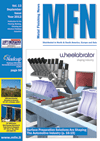E-Archive
Nadcap Column
in Vol. 13 - September Issue - Year 2012
Does Quality Assurance Improve Quality?
While any kind of focus on quality is a positive thing, don’t lose sight of the fact that quality assurance and quality improvement are not the same thing. Companies who confuse the two may find that they do not achieve the results they were expecting.
• Quality assurance (QA) describes the process by which organizations manage and account for the quality of their products and/or services to their stakeholders. For companies operating in highly regulated industries, this is the minimum quality expectation.
• Quality improvement (QI) is the way companies identify and act on opportunities to enhance the quality of their products and/or services to improve the value they offer to their stakeholders.
While QA is about the verification of quality, QI centers on continual improvement.
The not-for-profit Performance Review Institute utilizes a number of different approaches to ensure that the quality of the Nadcap program is assured yet open to continual improvement. These are shared in this article in support of PRI’s mission to add value for stakeholders in industries where safety and quality are shared goals.
Some of the ways in which the quality of the Nadcap program is assured are:
|
Approach |
Examples |
How supports QA |
|
Industry Management / External Oversight |
- Regular customer audits - Nadcap Management Council (voting members are experts from global aerospace prime contractors and suppliers) |
- Verifies compliance to procedure - Balances different customer needs - Ensures Nadcap impartiality - Facilitates customer oversight |
|
Strict Auditor Candidate Criteria |
- Pre-screening of resumés - Tests - Interviews - Audit Observations |
- Ensures Nadcap auditors are experts in their field |
|
Documentation |
- AS7003 - Quality Manual - Procedures - Work Instructions |
- Clarifies operational expectations - Ensures staff can always access the documentation for reference |
|
Staff Training |
- Formal induction training - Timely communication when procedures change |
- Ensures staff knowledge and understanding of procedures |
At the same time, there are a number of avenues that help to identify quality improvement opportunities, some of which are:
|
Approach |
Examples |
How supports QI |
|
Customer Feedback |
- Post-audit feedback form - Customer suggestions - Customer "Oversight" Audit - Supplier Support Committee (members are representatives from the international aerospace supply chain) |
- Provides an avenue for external input - Enables the expression of different perspectives on Nadcap operations |
|
Data Analysis |
- Nadcap Management Council Metrics (e.g. audit cycle time) - Task Group Metrics (e.g. number of non-conformances per checklist question) - Supplier Support Committee Metrics (e.g. supplier voting on Task Group ballots) |
- Defines goals - Evaluates status - Identifies opportunities for improvement - Records achievements that exceed expectations (which can be celebrated) |
|
Staff Suggestions |
- Suggestion box |
- Enables bottom-up feedback so Management can access suggestions based on staff "hands-on" expertise |
|
Industry Collaboration |
- Nadcap Management Council Sub-Committees (e.g. standardization sub-committee) - Supplier Support Committee Sub-Teams (e.g. flow down sub-team) |
- Generates ideas to optimize customer value through open discussion |
Like the Performance Review Institute, most companies work towards balancing QA and QI activities based on their particular business needs and situation.
A typical example of how the quality function might do this is by weighing up the demands of time, cost and quality. Ideally, quality would be weighted more heavily than the other two considerations, but more often than not the limitations of time and cost carry the most weight.
For accredited companies and other stakeholders, Nadcap has become acknowledged as a form of QA and QI: accreditation assures that the company has demonstrated a high competency level, while many companies have tracked quality improvements related to their Nadcap accreditation; a recent survey of 1,581 aerospace suppliers found that 85% report that Nadcap has helped them improve quality. Of course, Nadcap emphasizes process control, a key aspect of quality assurance that is not inspection-based. (A separate article will be published on this soon).
But is there a need to look at QI? Isn’t QA enough? The short answer is – it depends on the vision of the organization. If meeting the requirements is the goal, then QA will suffice. But if the company wants to exceed expectations and mark their position as an industry leader, there needs to be focus on QI as well, and this may require a cultural shift, as described in a recent article published by PRI (http://pri-network.org/PRI/Creating-a-Culture-of-Quality.id.1281.htm).
So, taking everything into account, the key question is: do you want your customers to view your company as one that is satisfied with meeting the minimum quality requirements or as one that goes over and above customer expectations in the pursuit of continual improvement?
For questions contact Joanna Leigh: joanna.leigh@pri-europe.org.uk




























